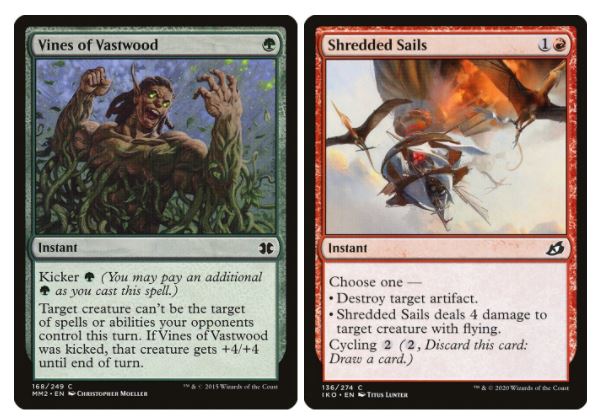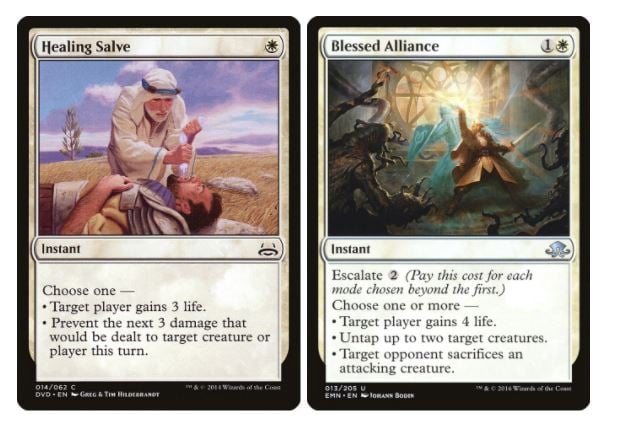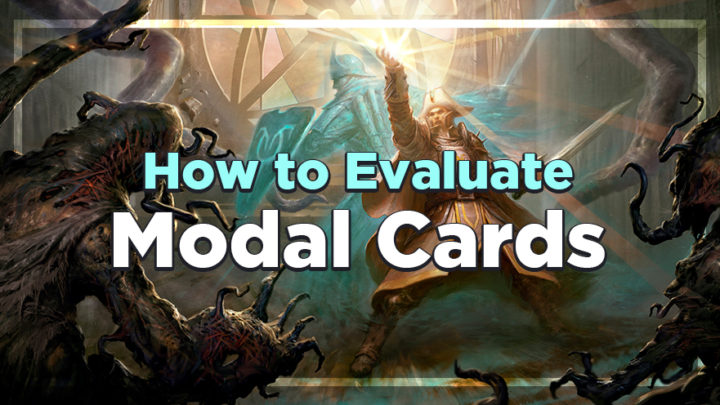Many are familiar with the adage “a jack of all trades is a master of none.” What most people don’t know, however, is that the phrase is incomplete. The full saying is “a jack of all trades is a master of none, but oftentimes better than a master of one.” The same can be said about Magic cards, especially in Commander.
As Kristen explained in her recent article, the most efficient card isn’t always the right choice for your deck. Modal cards see a lot of play in Commander for this very reason; you don’t always need the best possible solution for one specific problem, especially when there’s such a multitude of different questions you need to answer.
What is a modal card?
Modal cards are ones that provide you with multiple options, often at the cost of efficiency. The recent modal double-faced cards (MDFC’s) are perfect examples; even their name is a dead giveaway. Many green decks used to run Regrowth, but it’s since been replaced with Bala Ged Recovery. Recovery may be more expensive to cast, but it can be played as a land in the early game if needed; this makes it playable in more situations, and worth the extra mana cost.
Many new card designs, like adventures or MDFC’s, might seem to lean heavily toward modality, but there have been more modal spells throughout Magic’s long history than you might initially think. Lightning Bolt is my go-to example of a secretly modal card, as it has three different modes: Deal 3 damage to target creature, 3 damage to target planeswalker, or 3 damage to target player. When viewed through this lens, many cards start to become more appealing due to their more visible flexibility.

A number of Magic’s most beloved mechanics are modal. Let’s look at kicker, and take Vines of Vastwood as an example. It’s a single green mana for a protection spell, or you can cast a two-mana pump spell that also protects. (Incidentally, you can also target an opponent’s creature with Vines to fizzle any Auras or targeted spells of their own!) Cycling is another modal function, adding the ability to draw a card if none of the other options are currently relevant. This turns Shredded Sails from a somewhat narrow card into a flexible spell that’s never truly dead.
When is a modal card worth considering?
Now that you know how to spot modality in its many forms, how do you determine if it’s worth including in your deck? The heuristic I follow for determining a card’s overall usefulness is to ask myself, “Is there any reasonable situation where this card is either dead or not impactful?”

Unlike its red equivalent from Alpha, Healing Salve is much more situational, and often useless. It doesn’t answer a problem, but rather pushes the issue slightly further down the line; this is down to how narrow its options are, and how they all have fairly similar functions. Let’s compare that to Blessed Alliance: this is still a defensive spell, but it gives you the ability to choose from three very different options. Or does it? Blessed Alliance actually has seven different modes, thanks to escalate: you can choose a single mode, pay an extra two mana for your choice of two modes, or pay a total of six mana for all three! This makes Blessed Alliance a much more versatile spell, and more suitable to different situations.
Even though I just sang Blessed Alliance’s praises, it’s not a particularly impressive modal card. The reason for this is its window of usefulness. It’s only ever useful when you’re falling behind in a game; it can’t be used to press your advantage at any point, nor can it help you through a board stall. Interestingly, Marshall Sutcliffe’s approach to Quadrant Theory in Limited is surprisingly relevant to evaluating modal cards in Commander. Despite the wild differences between formats, the same core questions are still relevant:
- Does this help me establish my role in the early game?
- Can this help me break parity in the mid game?
- Will this help me to close the game when I’m ahead?
- Can this save me if I’m behind?
The majority of cards won’t satisfy all these criteria, but if the answer to at least two of these questions is “yes,” then you’re on the right track.
Underrated Modal Cards
Now that you know a little more about how to identify modal cards that are worth considering, you can start looking through your collection to see if there are any hidden gems tucked away in your rare binder or draft chaff. While many of the Charms from Ravnica (Boros Charm, Izzet Charm, etc.) and the Commands from Tarkir (Kolaghan’s Command, etc.) are incredibly popular, they may not always be the best choice for the card slot in your deck. I’ve included five of my favorite modal cards that don’t yet see enough play, if you’re looking for the next neat addition to your 99.
Kaya’s Guile
Early Game: No
Parity: Yes
Ahead: Yes
Behind: Yes
Kaya’s Guile is a fantastic example of a card whose modes aren’t good enough for a single card most of the time, but when you put onto a single card, you get a fantastic Swiss-army knife. Removing graveyards can shut down some value engines like Muldrotha, the Gravetide, and edict effects can hinder Voltron strategies. The other two modes can be very situational, though they’re also great mana sinks if you’re low on action in the mid game.
Grixis Charm
Early Game: Yes
Parity: Yes
Ahead: Yes
Behind: No
There are few cards that have as wide a range of effects as Grixis Charm. This doesn’t see much play (probably due to the color requirements), but I would consider running it if your deck contains these colors. Boomerang is a reasonable card by itself, as are Grasp of Darkness and Burn Bright; these spells are all much more situational, however, and wouldn’t usually deserve a card slot by themselves. Three very different, narrow effects in one card allows for extreme flexibility, and it’s not every day that you can turn a removal spell into a pseudo-Overrun!
Evolution Charm
Early Game: Yes
Parity: Yes
Ahead: Yes
Behind: No
Any creature-heavy deck running green should give some consideration to Evolution Charm. You can ensure your next land drop, rebuy a downed threat, or give a creature evasion to push through the last few points of damage. It’s not great at any particular job, but its wide scope is what gives it power. This can be a real all-star, especially in more casual decks.
Brutal Expulsion
Early Game: No
Parity: Yes
Ahead: Yes
Behind: Yes
I’m a huge fan of any card that can return spells to hand (Unsubstantiate, Divide By Zero, etc.), and Brutal Expulsion is one that’s often overlooked in Commander. There’s a long list of ways that this card interacts with your opponents, from pseudo-countering a spell while exiling a planeswalker, to removing two blockers as you try to close the game. It’s certainly named correctly, as Time Walking an opponent that tapped out for a sweeper can truly be brutal.
You don’t need to wait to get value from both parts of this spell, either: it’s almost always impactful, and four mana for just one of these effects is worth the flexibility this affords. With that said, getting maximum value from this can often feel incredible, so take the opportunity where you can!
Decisive Denial
Early Game: Yes
Parity: Yes
Ahead: Yes
Behind: No
Decisive Denial is a newcomer from Strixhaven, but it’s one that I feel will stay just under the radar. Soft counters aren’t particularly popular in Commander due to the abundance of mana ramp in the format, especially when those counters can only target noncreature spells. However, fight effects show up reasonably regularly in the format, and can pull a lot of weight in the right decks. The main downside to those spells is that they lose their power when your creatures are either too small or get removed, effectively rendering them useless.
Decisive Denial does a great job at making both Rabid Bite and Spell Pierce playable, and it does so by relying on one’s abilities to be relevant when the other isn’t. The counter half is great at preventing opponents from accelerating in the early game, or sniping a planeswalker or wrath at a timely moment. Having an instant-speed fight effect is extremely valuable to some decks, allowing you to wreak havoc in combat. It’s the perfect example of how modal cards are greater than the sum of their parts.
***
A jack of all trades can be just the thing you’re looking for, especially in Commander. Card slots can be tight in most decks, and getting extra value out of each one can be vital to a great performance. I hope this primer has been enlightening, and my examples help you to identify new favorites to play with.
What’s your favorite modal card? Are there any cards that you feel work well at all stages of the game? Let me know over on Twitter!

Scott is an Irish content creator and the Head of Budget Magic for the Izzet League. He focuses on affordable decks in Pioneer, Modern, and Pauper, particularly ones that stray from the mainstream. When he’s not writing about his favorite decks, he can be found talking incessantly about them on Twitter and on The Budget Magic Cast.

